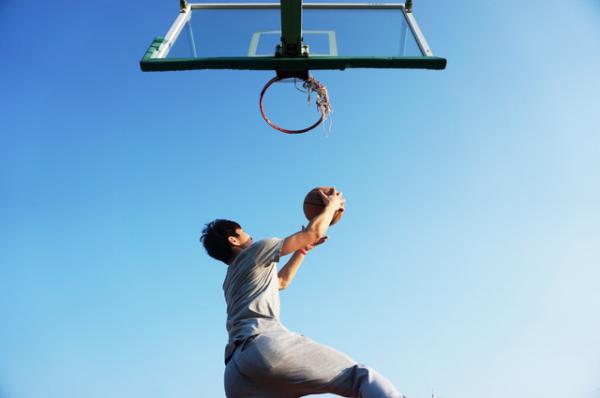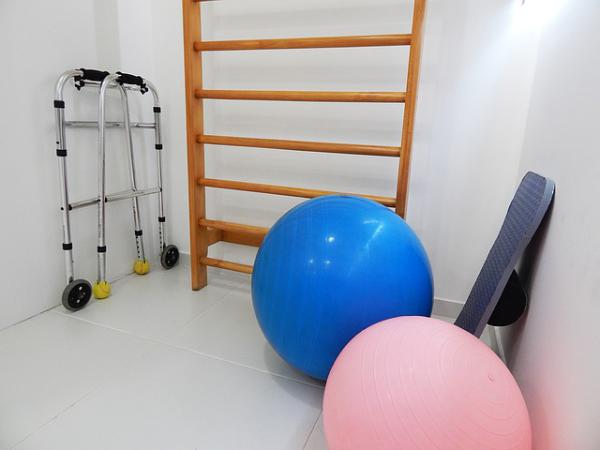Latest News and Information
Spring Sports and Outdoor Safety Tips from Cheyenne, WY Physical Therapy
April 11, 2018
Spring is an exciting time for athletes and those who exercise because of opportunities to work out and play sports outdoors. Running outdoors on a sunny day looking at the beautiful mountains is much more relaxing and enjoyable then indoors on a treadmill. When you are preparing for your spring sports and exercise, it is best to refresh your memory about outdoor workout safety. Learn about the different areas to be cautious about from premier Cheyenne, WY physical therapy.
Following the workout, it is equally important. When you take five to 10 minutes to cool down, you help slow your heart rate to its normal resting rate. For your cool down, you can do so by walking or swimming if in a pool. Be sure to complete a few stretches as well.
One of the key things to remember is proper hydration needs to happen throughout the day and not immediately before. Make sure to drink at least 64 ounces of water per day, but it will help to drink more, especially if your weight is higher. Prior to your workout, make sure to drink a couple glasses of water, and continue to drink water throughout. Depending on how much you sweat when active, you will need to bump up your hydration to make up for lost water. Following your workout, make sure you are drinking up to eight ounces right away.
Â
When you are in the middle of an attack, make sure to get to a cool area as soon as possible. Lay down, hydrate, and find ways to cool down as your body is struggling to do it on its own. Make sure you have someone assisting you and close by in case your condition worsens. If you find your symptoms are getting worse, go to a doctor or emergency room immediately. In severe cases, one may have a fever of over 104 degrees, or may even have a seizure.
Next, when increasing intensity, do not jump right into things. Build up so your body properly adjusts. When the body is stiff, this is when it is more likely for muscles to be pulled, or areas can become inflamed.
Last, having the proper gear and clothing is key. Make sure you are dressing properly for the outdoor elements to keep your temperature from being too hot or too cold. If you have special shoes, gloves, and other equipment, make sure it is tailored to you. When you have ill-fitted clothes or shoes, you increase your risk of injury.
When participating in sports or working out in the outdoors, make sure you always have a form of ID with you. Keep valuables at home and be vigilant. Makes sure you are aware of everything around you to prevent from someone taking advantage of you in the moment of surprise. If you are running or biking on a street, make sure you are going against traffic. This will ensure vehicles will see you.
As an athlete or person who enjoys (or doesn’t enjoy) working out, one of the best things you can do to improve the quality of workouts is to see a physical therapist. North Platte Physical Therapy is your go-to physical therapist. Our team will assist with proper form, tips, and all other things you need to be successful. Contact us today to see how we can help you work out safely.
Read More...
Importance of Warming Up and Cooling Down
When starting a workout, you may want to jump right in, especially if you are short on time. However, when you take five to 10 minutes to warm up your body before a workout, you prepare your body to push itself. Your blood flow will increase to your muscles therefore, loosening them up. When your muscles are more flexible, you will reduce the risk of stiffness that could lead to an injury. When you warm up, focus on stretching and mild aerobics to get your blood pumping.Following the workout, it is equally important. When you take five to 10 minutes to cool down, you help slow your heart rate to its normal resting rate. For your cool down, you can do so by walking or swimming if in a pool. Be sure to complete a few stretches as well.
Proper Hydration
Hydration, in general, is important. If you exercise regularly or play sports, you especially need to make sure you are properly hydrating. When you do not drink enough water, you will not be able to perform as well. Your muscles will not be at their best and you may experience cramping and other negative side effects. Why? Water helps the body heal quicker and perform at an optimal level. ÂOne of the key things to remember is proper hydration needs to happen throughout the day and not immediately before. Make sure to drink at least 64 ounces of water per day, but it will help to drink more, especially if your weight is higher. Prior to your workout, make sure to drink a couple glasses of water, and continue to drink water throughout. Depending on how much you sweat when active, you will need to bump up your hydration to make up for lost water. Following your workout, make sure you are drinking up to eight ounces right away.
Avoid Heat Exhaustion
When the body overheats, one can experience heat exhaustion. It occurs when a person overexerts themselves and has not properly hydrated. The body then hits a point where it is unable to cool itself down. In some cases, outdoor temperature can play a role but is not always the case. If you notice the following symptoms, you may be suffering from heat exhaustion:Â
- Dizziness and fatigue
- Headaches
- Paleness and clamminess
- Nausea or vomiting
- Muscle cramps
- Fever
When you are in the middle of an attack, make sure to get to a cool area as soon as possible. Lay down, hydrate, and find ways to cool down as your body is struggling to do it on its own. Make sure you have someone assisting you and close by in case your condition worsens. If you find your symptoms are getting worse, go to a doctor or emergency room immediately. In severe cases, one may have a fever of over 104 degrees, or may even have a seizure.
Exercise Safety
In addition to proper hydration, warming up, and cooling down, there are additional ways to ensure you are safe when exercising. First, understand the difference between pushing through and actual pain. If you are working out and something is painful or does not feel right, stop. It could be an injury that you can worsen at a rapid rate. One of the top ways to perform at your best is to go to your local physical therapist. They can help you with proper form.Next, when increasing intensity, do not jump right into things. Build up so your body properly adjusts. When the body is stiff, this is when it is more likely for muscles to be pulled, or areas can become inflamed.
Last, having the proper gear and clothing is key. Make sure you are dressing properly for the outdoor elements to keep your temperature from being too hot or too cold. If you have special shoes, gloves, and other equipment, make sure it is tailored to you. When you have ill-fitted clothes or shoes, you increase your risk of injury.
When participating in sports or working out in the outdoors, make sure you always have a form of ID with you. Keep valuables at home and be vigilant. Makes sure you are aware of everything around you to prevent from someone taking advantage of you in the moment of surprise. If you are running or biking on a street, make sure you are going against traffic. This will ensure vehicles will see you.
Tips for Athletes
In addition to properly exercising, there are additional things athletes can do for a successful workout. These include:- Provide at least one day for rest
- Work out regularly so your body adjusts and is not more susceptible to injury
- Properly fuel yourself before a workout by eating a snack that will fuel your workout and give you the energy to push through
- Know what your caloric intake should be, which is different for everyone. It is determined by your height, weight, and goals. Get started and calculate your body mass index.
- Make sure you eat enough protein which will help you recover more quickly after a workout
- In addition to proper hydration, you can drink other types of beverages that will restore electrolytes
- Find exercises and sports that you love, this will keep you motivated to keep up your workout routines
As an athlete or person who enjoys (or doesn’t enjoy) working out, one of the best things you can do to improve the quality of workouts is to see a physical therapist. North Platte Physical Therapy is your go-to physical therapist. Our team will assist with proper form, tips, and all other things you need to be successful. Contact us today to see how we can help you work out safely.
Common Causes for Headaches and Using Physical Therapy in LaGrange, WY to Help
April 4, 2018
Headaches are a common occurrence in nearly 50 million Americans each year. For some, it may be an occurrence that happens every couple months, while for others, headaches happen daily. Regardless of the frequency, they are a nuisance and, in some cases, debilitating. If you are a frequent headache-sufferer, it is best to explore your options for relief and talk to your doctor. There could be an underlying issue that needs solved. Your doctor can assist you to discover the root of your headaches and having premier Cheyenne, WY physical therapy assist.
If you are ready to get help with your headaches and migraines, North Platte Physical Therapy is your go-to local physical therapist. Our team will work with you to create a series of exercises to provide relief and enhance the quality of your life. Never been to a physical therapist before? Here is what to expect on your first visit to North Platte Physical Therapy. Get started and contact North Platte Physical Therapy today to find a location near you.
Read More...
Types of Headaches
Headaches can occur for a variety of reasons. In the Mayo Clinic’s causes for headaches, they explain there are five different types: cluster, migraine, migraine with aura, tension headache, and trigeminal autonomic cephalgia (TAC)—known as a “cluster headache.†Within this group, there are actually over 100 types of headaches and causes. Some of the main causes of headaches include:- Light sensitivity
- Food and alcohol
- Glare from TV, computer or smartphone screens
- Overexertion while exercising or lack of exercise
- Stress and anxiety
- Dehydration
- Lack of sleep
- Poor posture
- Cold, allergies or sickness
- TMJ disorder
Difference Between a Migraine and a Headache
There are specific differences between headaches and migraines. Headaches are painful, often with an ache or pressure feeling. They can occur anywhere on the head such as the temples, eyes, or back of the head. They are uncomfortable and painful. Migraines take things a step further. In addition to the pain in your temples, forehead, etc., there are additional symptoms. Nausea, pain behind the eye, and light sensitivity are some of the common symptoms. In addition, migraines can actually impact your vision by causing spots or “floaters†to appear in your line of sight. In other cases, your eye may severely blur, making it difficult to see. Many migraine sufferers experience “auras,†also known as an ocular migraine. This means part of your vision is affected, more than usual. Auras can cause blind spots, zig zags or pixelated vision, and flashing. In addition, some have reported hallucinations. When a migraine sets in, it makes it very difficult to function. If you notice you have migraines often, it is important to speak with your doctor about them as soon as possible.Ways to Alleviate Symptoms
There are several ways to cope with headaches and migraines. You definitely do not need to suffer. One of the top ways people treat their migraines is with medication. Medications such as Excedrin have a combination of acetaminophen and/or aspirin, as well as and caffeine to help combat symptoms fast. Next are oils. Lavender and peppermint are soothing. You can actually go to your local drug store to find roller sticks. Food and water may also impact your headaches. Make sure to eat a healthy diet and always stay hydrated. Last, you can also treat your headaches with physical therapy. They will work with you to reduce stress and tension that may be negatively impacting you body.If you are ready to get help with your headaches and migraines, North Platte Physical Therapy is your go-to local physical therapist. Our team will work with you to create a series of exercises to provide relief and enhance the quality of your life. Never been to a physical therapist before? Here is what to expect on your first visit to North Platte Physical Therapy. Get started and contact North Platte Physical Therapy today to find a location near you.
Use Physical Therapy in Casper, WY for Your Child's Walking Issues
March 28, 2018
If your child is not walking properly, it is best to address and handle the issue right away to avoid larger issues later in life. While getting started can seem overwhelming, your doctor and local physical therapy in Casper, WY is there to help. Learn more about what toe walking is, top signs to watch out for, and how to care with a quality physical therapist by your side.
If you notice your child is toe walking past their toddler years, contact North Platte Physical Therapy for help. We have a variety of locations to make it convenient for your family’s schedule. Contact us today to get started.
Read More...
What is Toe Walking?
When a person walks normally, they propel themselves starting with the heel of the foot hitting the ground first, then rolling up to the ball of the foot and toes. This will help build momentum for a forward motion. However, it is fairly common for children to get into the habit of walking on their toe or the balls of their feet. While many outgrow this way of walking, some do not. If you notice your child is toe walking past their toddler years, it is important to have a conversation with your doctor.Common Causes, Signs and Symptoms
The main thing to watch for in children that toe walk is their progression. If a toddler continues to walk on the tip of their toes or top of their feet, it could be due to condition. Some of these include:- Autism: Toe walking occurs in children with autism because it is a neurological disorder. For some children, they are sensitive to different sensation and prefer toe walking. Regardless, it will need to be corrected.
- Cerebral palsy: Children with cerebral palsy may commonly toe walk because they do not have the muscle functionality that allows them to do so.
- Muscular and spinal issues: For those with issues with their spinal cord, or have muscular dystrophy, may be more likely to toe walk due to neurological issues.
- Shortened Achilles tendon: When the Achilles tendon, which connects the bottom part of the leg to the heel of one’s foot, it can create issues. One of the key signs is toe walking as a child physically struggles with letting their heel hit the ground when they walk.
Care and Physical Therapy
No matter what the reason is for your child’s toe walking, you can have a conversation with your doctor on care tips. In addition, a physical therapist will be your go-to solution. Specializing in pediatric therapy, premier physical therapists are trained to create custom plans for children with motor impairments.If you notice your child is toe walking past their toddler years, contact North Platte Physical Therapy for help. We have a variety of locations to make it convenient for your family’s schedule. Contact us today to get started.
Ways Wheatland Physical Therapy Can Ease Plantar Fasciitis
March 21, 2018
A quarter of Americans are coping with a painful foot condition: Plantar fasciitis. Due to inflammation in the area, every day activities such as walking can be difficult. Seeking help is important to be able to handle day-to-day tasks. Learn more about plantar fasciitis, ways to manage the condition, and top ways to incorporate Wheatland physical therapy and all our other locations in your recovery plan.
This condition can occur due to a variety of reasons including:
In addition, they may also recommend a night splint if your ankle or toes are not in their proper position. Taping is also common for quick relief in some instances. They will walk you through each of these steps.
As you are working to find a solution for your plantar fasciitis, North Platte Physical Therapy can help. We treat a variety of orthopedic injuries, including plantar fasciitis, and will help you get on the path to recovery. With locations all over Wyoming and one in Gering, Nebraska, you are sure to find an office near you. Get started and contact us today!
Read More...
What is Plantar Fasciitis?
Plantar fasciitis occurs when the thick band of tissue that connects the heel of your foot to your toes becomes inflamed. This inflammation can happen due to small tears to the ligament, anywhere in the area, causing the bottom of the foot and/or the heel to be in pain.This condition can occur due to a variety of reasons including:
- Wearing improper footwear for specific tasks
- Landing on the feet improperly after a jump
- Failure to properly stretch before exercising
- Being on your feet all day without breaks
- High arches or flat feet
- Overweight
Go-To Ways to Cope
If you feel you may have plantar fasciitis, it is important to see your doctor. They will be able to assess the severity of your individual situation. In addition, there are other things you can do to ease the pain.- Make sure you have time in your day where you can be off your feel and allow them to rest, so the swelling reduces
- Purchase custom shoes or shoe inserts with arch support that will help cushion the area
- Take anti-inflammatory medications
- Ice the area
Top Ways to Incorporate Physical Therapy
In addition to your doctor’s treatment recommendations, premier physical therapy will also help alleviate the symptoms of plantar fasciitis. How? Through various exercises tailored to your specific situation, your local physical therapist will help you strengthen the muscles in the area.In addition, they may also recommend a night splint if your ankle or toes are not in their proper position. Taping is also common for quick relief in some instances. They will walk you through each of these steps.
As you are working to find a solution for your plantar fasciitis, North Platte Physical Therapy can help. We treat a variety of orthopedic injuries, including plantar fasciitis, and will help you get on the path to recovery. With locations all over Wyoming and one in Gering, Nebraska, you are sure to find an office near you. Get started and contact us today!
Understanding Myofascial Pain Syndrome and Using Physical Therapy in Cheyenne, WY
March 13, 2018
Do you have consistent pain that you feel deep in your muscles? It may not be something that will go away on its own, especially if it is myofascial pain syndrome. It is important to recognize the top symptoms of this condition, and work with your doctor for treatment. In addition, local physical therapy in Cheyenne, WY will also help during the healing process.
Â
If you are coping with myofascial pain syndrome, our team at North Platte Physical Therapy will create a plan unique to your recovery. This is pain you do not have to deal with and we will work with you to restore the quality of your muscles. Contact us today to schedule your appointment.
Read More...
What is myofascial pain syndrome?
Myofascial pain syndrome is a chronic pain felt within one’s muscles. It occurs when there is inflammation, often causing a feeling that there is a knot. This pain is from the fascia, hence the name, which is the connective tissue over the muscles. It can be in one muscle, or several. Many people experience muscle pain, especially strains. Myofascial pain syndrome is a condition where the pain does not improve and worsens over time.Signs and symptoms
One of the go-to signs you may have myofascial pain syndrome is a tender to deep pain within your muscles. This can occur anywhere from the neck and shoulder, to the upper or lower back region. More specifically, it may feel like a knot that you can’t get out of an area that may also spasm. It can cause discomfort during the day and make it difficult to sleep at night. There may be a noticeable swelling in the area, along with a warming sensation.Possible causes
Myofascial pain syndrome can be caused by a variety of reasons. One of the most common is repetitive motions or overuse. When this occurs, it develops trigger points within the muscles, causing improper blood flow. It can be contained to one area or radiate to other areas in the body.When to see a doctor
It is best to see a doctor when you know your muscle pain is severe or unusual for you. If it persists for weeks, or shows any of the symptoms above, call your doctor so you can work to a plan of recovery as soon as possible. To help with relief, they may recommend anti-inflammatory medication, such as ibuprofen, or pain medication. Icing the area can help, too. In other cases, if swelling and pain is on the severe side, steroids may be prescribed.Using physical therapy to treat
Your premier physical therapist will play a crucial role in your recovery. Two ways they can help are through massage and trigger point therapy. With massage therapy, your physical therapist will use various therapeutic massage techniques to help relax your muscles. Second, trigger point therapy, also known as dry needling, may also be used. This form of therapy will help break up the trigger points and knots in the muscles, allowing for relief and range of motion.Â
If you are coping with myofascial pain syndrome, our team at North Platte Physical Therapy will create a plan unique to your recovery. This is pain you do not have to deal with and we will work with you to restore the quality of your muscles. Contact us today to schedule your appointment.




